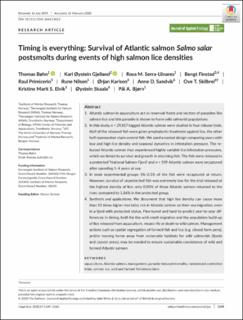| dc.contributor.author | Bøhn, Thomas | |
| dc.contributor.author | Gjelland, Karl Øystein | |
| dc.contributor.author | Serra Llinares, Rosa Maria | |
| dc.contributor.author | Finstad, Bengt | |
| dc.contributor.author | Primicerio, Raul | |
| dc.contributor.author | Nilsen, Rune | |
| dc.contributor.author | Karlsen, Ørjan | |
| dc.contributor.author | Sandvik, Anne Dagrun | |
| dc.contributor.author | Skilbrei, Ove Tommy | |
| dc.contributor.author | Elvik, Kristine Marit Schrøder | |
| dc.contributor.author | Skaala, Øystein | |
| dc.contributor.author | Bjørn, Pål Arne | |
| dc.date.accessioned | 2020-10-16T12:08:27Z | |
| dc.date.available | 2020-10-16T12:08:27Z | |
| dc.date.created | 2020-04-15T12:11:16Z | |
| dc.date.issued | 2020 | |
| dc.identifier.citation | Journal of Applied Ecology. 2020, 57 (6), 1149-1160. | en_US |
| dc.identifier.issn | 0021-8901 | |
| dc.identifier.uri | https://hdl.handle.net/11250/2683356 | |
| dc.description.abstract | Atlantic salmon in aquaculture act as reservoir hosts and vectors of parasites like salmon lice and this parasite is shown to harm wild salmonid populations.
In this study, n = 29,817 tagged Atlantic salmon were studied in four release trials. Half of the released fish were given prophylactic treatment against lice, the other half represented sham control fish. We used a nested design comparing years with low and high lice density and seasonal dynamics in infestation pressure. The released Atlantic salmon thus experienced highly variable lice infestation pressures, which we linked to survival and growth in returning fish. The fish were released in a protected ‘National Salmon Fjord’ and n = 559 Atlantic salmon were recaptured after spending 1–4 years at sea.
In most experimental groups 1%–2.5% of the fish were recaptured at return. However, survival of unprotected fish was extremely low for the trial released at the highest density of lice: only 0.03% of these Atlantic salmon returned to the river, compared to 1.86% in the protected group.
Synthesis and applications. We document that high lice density can cause more than 50 times higher mortality risk in Atlantic salmon on their sea migration, even in a fjord with protected status. Fine‐tuned and hard‐to‐predict year‐to‐year differences in timing, both for the wild smolt migration and the population build‐up of lice released from aquaculture, means life or death to wild salmon. Management actions such as spatial segregation of farmed fish and lice (e.g. closed farm pens), and/or moving farms away from vulnerable habitats for wild salmonids (fjords and coastal areas), may be needed to ensure sustainable coexistence of wild and farmed Atlantic salmon. | en_US |
| dc.language.iso | eng | en_US |
| dc.relation.uri | https://hdl.handle.net/11250/2651128 | |
| dc.title | Timing is everything: Survival of Atlantic salmon Salmo salar postsmolts during events of high salmon lice densities | en_US |
| dc.type | Peer reviewed | en_US |
| dc.type | Journal article | en_US |
| dc.description.version | publishedVersion | en_US |
| dc.subject.nsi | VDP::Zoologiske og botaniske fag: 480 | en_US |
| dc.subject.nsi | VDP::Zoology and botany: 480 | en_US |
| dc.source.pagenumber | 1149-1160 | en_US |
| dc.source.volume | 57 | en_US |
| dc.source.journal | Journal of Applied Ecology | en_US |
| dc.source.issue | 6 | en_US |
| dc.identifier.doi | 10.1111/1365-2664.13612 | |
| dc.identifier.cristin | 1806324 | |
| dc.relation.project | Havforskningsinstituttet: 14650 | en_US |
| dc.relation.project | Norges forskningsråd: 221404 | en_US |
| dc.relation.project | Norsk institutt for naturforskning: 160022/F40 | en_US |
| cristin.ispublished | true | |
| cristin.fulltext | original | |
| cristin.qualitycode | 2 | |
